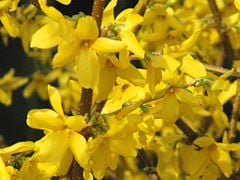Forsythia
- For other uses, see Forsythia (disambiguation).
| Forsythia | ||||||||||||
|---|---|---|---|---|---|---|---|---|---|---|---|---|
 Forsythia x intermedia
| ||||||||||||
| Scientific classification | ||||||||||||
| ||||||||||||
|
See text |
Forsythia is a genus of flowering plants in the family Oleaceae (olive family). There are about 11 species, mostly native to eastern Asia, but one native to southeastern Europe. The common name is also Forsythia; the genus is named after William Forsyth.[1][2][3]
The leaves are opposite, usually simple but sometimes trifoliate with a basal pair of small leaflets, and
Description
The Oleaceae, or olive family, is a plant family containing 24 extant genera and around 600 species of mesophytic shrubs, trees and occasionally vines. As shrubs, members of this family may be twine climbers, or scramblers.
The family is characterized by opposite leaves that may be simple or compound (either pinnate or ternate), without stipule. Alternate or whorled arrangements are rarely observed, with some Jasminum species presenting spiral configuration. The lamina are pinnately-veined and can be serrate, dentate or entire at margin. Domatia are observed in certain taxa. The leaves may be either deciduous or evergreen, with evergreen species predominating in warm temperate and tropical regions, and deciduous species predominating in colder regions.
The flowers are most often bisexual and actinomorphic, occurring in panicles, racemes or panicles, and often fragrant. The calyx, which may or may not be present, and the corolla are synsepalous and four-lobed. The androecium has 2 stamens inserted in the perigynous zone and alternate with the lobes. The stigmas are two-lobed.
The gynoecium consists of a compound pistil with two carpels. The ovary is superior with two locules, each of which bearing two axillary ovules. Sometimes the base of the ovary is circled by a nectary disk. The plants are most often hermaphrodite but sometimes polygamomonoecious.
Forsythia: They are deciduous shrubs typically growing to a height of 1–3 m (3–9 ft.) and, rarely, up to 6 m (18 ft.), with rough gray-brown bark. The leaves are opposite, usually simple but sometimes trifoliate with a basal pair of small leaflets, and range from 2–10 cm (1–4 in.) in length and, rarely, up to 15 cm (6 in.) long; the margin is serrated or entire. The flowers are produced in the early spring before the leaves, bright yellow with a deeply four-lobed corolla, the petals joined only at the base. The fruit is a dry capsule, containing several winged seeds.[1][4]
- Species
- Forsythia europaea Degen & Bald. Balkans in Albania and Kosovo.
- Forsythia giraldiana Lingelsh. Northwest China.
- Forsythia japonica Makino. Japan.
- Forsythia likiangensis Ching & Feng ex P.Y.Bai. Southwest China.
- Forsythia mandschurica Uyeki. Northeast China.
- Forsythia mira M.C.Chang. North central China.
- Forsythia nakaii (Uyeki) T.B.Lee. Korea.
- Forsythia ovata Nakai. Korea.
- Forsythia suspensa (Thunb.) Vahl. Eastern and central China.
- Forsythia togashii H.Hara. Japan (Shōdoshima).
- Forsythia viridissima Lindley. Eastern China.
A genetic study[6] does not fully match the traditionally accepted species listed above, and groups the species in four clades: (1) F. suspensa; (2) F. europaea — F. giraldiana; (3) F. ovata — F. japonica — F. viridissima; and (4) F. koreana — F. mandschurica — F. saxatilis. Of the additional species, F. koreana is usually cited as a variety of F. viridissima, and F. saxatilis as a variety of F. japonica;[7] the genetic evidence suggests they may be better treated as distinct species.
Forsythias are used as food plants by the larvae of some Lepidoptera species including Brown-tail and The Gothic.
Cultivation and uses
The hybrids Forsythia × intermedia (F. suspensa × F. viridissima) and Forsythia × variabilis (F. ovata × F. suspensa) have been produced in cultivation.[4]
Forsythias are popular early spring flowering shrubs in gardens and parks. Two are commonly cultivated for ornament, Forsythia × intermedia and Forsythia suspensa. They are both spring flowering shrubs, with yellow flowers. They are grown and prized for being tough, reliable garden plants. Forsythia × intermedia is the more commonly grown, is smaller, has an upright habit, and produces strongly coloured flowers. Forsythia suspensa is a large to very large shrub, can be grown as a weeping shrub on banks, and has paler flowers. Many named garden cultivars can also be found.[4]
Commercial propagation is usually by cuttings, taken from green wood after flowering in late spring to early summer; alternatively, cuttings may be taken between November and February.[4]
F. suspensa (Chinese: 连翘; pinyin: liánqiào) is considered one of the 50 fundamental herbs in Chinese herbology. Forsythia sticks are used to bow a Korean string instrument called ajaeng.
ReferencesISBN links support NWE through referral fees
- ↑ 1.0 1.1 1.2 Flora of China: Forsythia
- ↑ 2.0 2.1 Flora Europaea: Forsythia
- ↑ 3.0 3.1 St Andrews Botanic Garden: Plant of the Month: Forsythia
- ↑ 4.0 4.1 4.2 4.3 4.4 Huxley, A., ed. (1992). New RHS Dictionary of Gardening. Macmillan ISBN 0-333-47494-5.
- ↑ University of Oxford, Oleaceae information site: Forsythia
- ↑ Kim, K.-J. (1999). Molecular phylogeny of Forsythia (Oleaceae) based on chloroplast DNA variation. P. Syst. Evol. 218: 113-123. Abstract.
- ↑ Germplasm Resources Information Network: Forsythia
External links
- BBC - Forsythia page
- Royal Horticultural Society
- Forsythia viridissima Vanderbilt University - Forsythia page
Credits
New World Encyclopedia writers and editors rewrote and completed the Wikipedia article in accordance with New World Encyclopedia standards. This article abides by terms of the Creative Commons CC-by-sa 3.0 License (CC-by-sa), which may be used and disseminated with proper attribution. Credit is due under the terms of this license that can reference both the New World Encyclopedia contributors and the selfless volunteer contributors of the Wikimedia Foundation. To cite this article click here for a list of acceptable citing formats.The history of earlier contributions by wikipedians is accessible to researchers here:
The history of this article since it was imported to New World Encyclopedia:
Note: Some restrictions may apply to use of individual images which are separately licensed.




